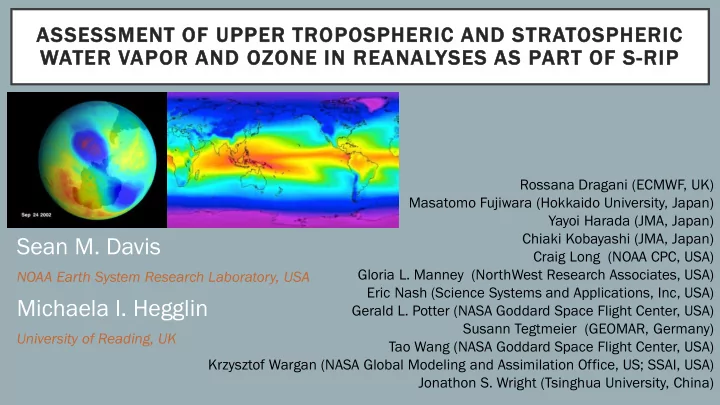

ASSESSM SESSMEN ENT O OF UPPER T TROPOSPHERIC AND STRATOSPHERIC WATER V VAPOR OR A AND OZON OZONE IN IN REANALYSES SES AS AS P PAR ART O OF S-RIP RIP Rossana Dragani (ECMWF, UK) Masatomo Fujiwara (Hokkaido University, Japan) Yayoi Harada (JMA, Japan) Chiaki Kobayashi (JMA, Japan) Sean M. Davis Craig Long (NOAA CPC, USA) Gloria L. Manney (NorthWest Research Associates, USA) NOAA Earth System Research Laboratory, USA Eric Nash (Science Systems and Applications, Inc, USA) Michaela I. Hegglin Gerald L. Potter (NASA Goddard Space Flight Center, USA) Susann Tegtmeier (GEOMAR, Germany) University of Reading, UK Tao Wang (NASA Goddard Space Flight Center, USA) Krzysztof Wargan (NASA Global Modeling and Assimilation Office, US; SSAI, USA) Jonathon S. Wright (Tsinghua University, China)
MOTIVATION • Stratospheric O 3 is Earth’s UV shield • Stratospheric WV and O 3 are radiatively active– affect T in stratosphere, and have a RF • Strat WV impacts O 3 • Strat WV is a climate feedback (~ ice-albedo feedback) Solomon et al., 2010
OVERVIEW • Material from S-RIP Ch. 4 and Davis et al. (ACP, 2017) • Treatment of water vapor and ozone in reanalyses • Observational data for comparison • Evaluation of ozone • Evaluation of water vapor • Conclusions and guidance for users • Ke Key R Results: • Ozone: Column amount well represented. Vertical profile less consistent, with biases in upper troposphere and lower stratosphere (UTLS). • Water vapor: Poorly (or not) represented in stratosphere
OZONE TREATMENT IN REANALYSES • Ozone treatment varies greatly TC TCO • Assimilate total column ozone from TOMS or SBUV • Some assimilate vertically resolved obs Profile
WATER VAPOR TREATMENT IN REANALYSES • Tropospheric WV assimilated (not covered) • Stratospheric WV not assimilated • Strat. WV representation highly variable • Most reanalyses have prognostic WV, except NCEP-NCAR & MERRA* (relaxation) • Prognostic representation means control by physical processes • Dehydration at tropical tropopause • Methane oxidation source in stratosphere
OBSERVATIONAL DATA FOR COMPARISON • Non-indepdendent data: TOMS and SBUV/2 total column ozone • (Quasi-) indepdendent data: SPARC-DI (2005-2010 climatology) and SWOOSH (1984 - ) SWOOSH SPARC DI Hegglin et al., JGR, 2013 Davis et al., ESSD, 2016
EVALUATION OF COLUMN OZONE CLIMATOLOGY (1981 - 2010) • Reanalyses generally agree best with the TCO data set they assimilate
EVALUATION OF OZONE VERTICAL STRUCTURE • Reanalyses have upper stratosphere low bias, lower stratosphere high bias • Limb observations generally agree within ±5% in UTLS -> real bias
EVALUATION OF OZONE: OZONE HOLE • Reanalyses reproduce the ozone hole reasonably well when they have input obs (not available during polar night) • Only ERA* reanalyses represent ozone hole chemistry
EVALUATION OF WATER VAPOR: VERTICAL STRUCTURE • Reanalyses have strong high biases relative to SPARC DI in UTLS region • Possible obs. issue • MERRA* relaxes to MLS
SUMMARY Ozone ne: • Reanalyses generally reproduce total column amounts well, within ~10 DU (3%) • Expected, because they assimilate this data! • Except during polar night, when observations aren’t available • Vertical structure is constrained by simple parameterizations • Largest biases in UTLS and upper stratosphere Water va r vapor: r: • No observations assimilated in stratosphere • Stratospheric data should generally not be used in scientific studies • Plenty of room for improvement in stratospheric O 3 and WV in reanalyses!
Recommend
More recommend